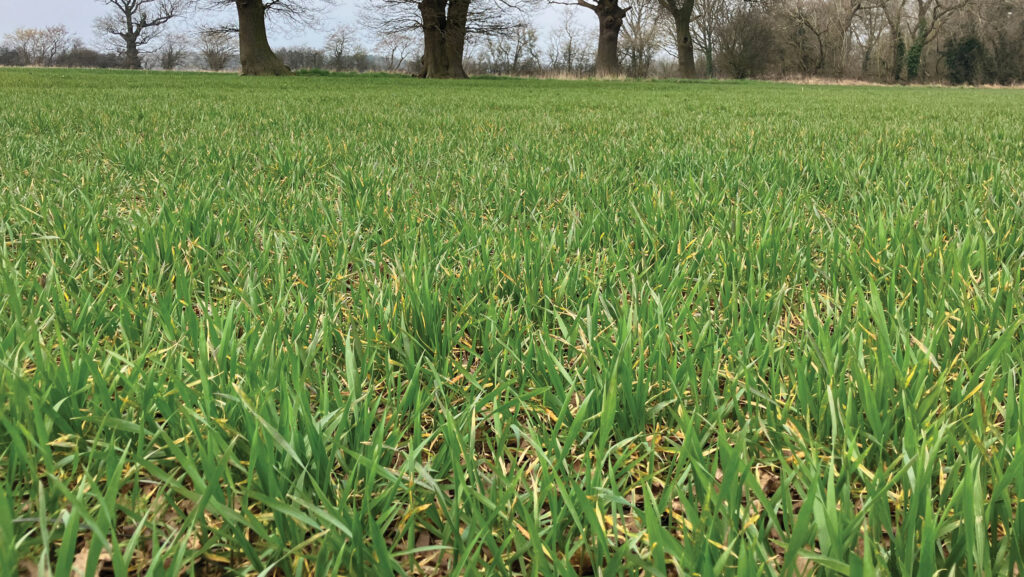Why one farmer believes calcium is king of soil nutrients
 Tim Parton © Richard Stanton
Tim Parton © Richard Stanton Calcium forms the foundations of good crop nutrition, according to farmer and independent regenerative agriculture consultant Tim Parton.
“Calcium is the juggernaut of elements, driving nutrition around the plant. Available calcium is critical to a healthy crop. It is essentially the glue which binds plants together – nothing functions without it,” says Tim.
The element is involved in a host of important plant functions ranging from root development and nutrient uptake, to cell signalling and managing stress tolerance.
See also: Strip-till cultivator brings big maize establishment savings
What causes calcium deficiency in crops?
- Calcium mobility: Calcium is not mobile within plants, so once it is deposited in tissues, it does not move. If crops do not receive enough calcium early on, deficiency symptoms can appear in new growth, such as leaf tip burn.
- Soil pH Imbalance: Calcium is more available to plants when the soil pH is neutral (6–7). Soils that are too acidic or too alkaline limit availability.
- Excessive fertiliser: High levels of nitrogen and potassium fertilisers limit calcium uptake. Excessive nitrogen, particularly in ammonium form, and excessive potassium reduce calcium uptake.
- Poor root development: Underdeveloped root systems in compacted soils with poor soil biology and structure can lower calcium uptake.
- High magnesium or sodium: High concentrations of magnesium or sodium can compete with calcium for absorption by the roots. Applying gypsum (calcium sulphate) can be beneficial to reduce excess magnesium, displacing it from the cation exchange sites on soil particles.**
It also has close synergistic relationships with boron and silicon. “If you are deficient in calcium, you will be likely deficient in these as well.”
This is why Tim has actively included calcium (Ca) into his nutrition programmes for the past decade at his farm in south Staffordshire.
He kick-starts the season with an application of granular calcium fertiliser, known as Calcifert, across all 300ha of cropping, including grassland.
“In mid-February, we go in with a rate of 100-150kg Ca/ha, which should be available to the plant within six weeks of application,” he says.
Every 10-14 days throughout the growing season, sap tests are taken to determine if foliar calcium top-ups – alongside a mix of other nutrients – are required.
“We usually apply between one to seven foliar calcium sprays, at 1-5 litres/ha, dependent on the season and crop conditions.”
Adequate calcium levels in both the soil and plant is important. “To me, calcium really is the king of nutrients and that’s where my nutrition planning starts.”

Tim Parton’s winter wheat © MAG/Emma Gillbard
Cell wall strength
Calcium is a crucial component in the formation of plant cell walls. It helps in the binding of pectin to cellulose, which strengthens the cell wall and enhances its structure.
Adequate calcium levels in plants contribute to improved disease and pest resistance. Stronger cell walls make it physically harder for pathogens such as fungi and bacteria, as well as pests, to penetrate the leaf surface.
It also helps stimulate production of natural defence chemicals, such as phytoalexins, which fight off disease. “There is normally a running theme with yellow rust, that the plant will have low calcium levels” explains Tim.
“If you haven’t got optimum calcium levels, crops will have weaker cell walls which are prone to fungal infections. The plant simply doesn’t have it’s own natural armour.”
“It’s all about optimising plant health. A healthy plant doesn’t need synthetic fungicides or insecticides to protect it. This is how I’ve been able to step away from their use,” notes Tim.
Enhanced nutrient uptake
Calcium plays a significant role in facilitating the uptake of essential nutrients, such as nitrogen, phosphorus, potassium, manganese, zinc, iron, and magnesium within the plant.
It helps to activate enzymes that control the movement of nutrients across cell membranes.
Calcium is closely linked with mycorrhizal fungi soil interactions. Sufficient calcium promotes root biomass, helping the formation of root tips and encouraging root elongation.
“A bigger root mass has greater access to nutrients and water, which contributes to a healthier and stronger plant. I’m trying to get crops to explore the soil to get the nutrition they need, which is how nature intended it to be,” says Tim.
However, in “a drug-addicted soil” which is reliant on artificial fertilisers, root mass is limited because the plant doesn’t need to go looking for nutrients. In fact, too much nitrogen and potassium can limit calcium uptake.
Soil health and structure

Good soil aggregation © Tim Parton
A sufficient soil calcium level enhances soil aggregation and allows the soil to breathe, helping flocculate clay particles and develop stable soil aggregates.
“Improved aggregation means crops are able to germinate quicker. It also improves water infiltration rates and allows plants to access water more easily,” says Tim.
Calcium has the ability to hold more water in the soil, which is particularly helpful in times of drought stress or waterlogging. “It also helps unlock water from the soil to make it available to plants,” he says.
Increased stress tolerance
Calcium plays a vital role in cell signalling and cell division, informing cells when to divide in order to build and grow.
Acting as a secondary messenger, the element is involved in transmitting signals from external stimuli to cellular processes, so the plant can respond to various environmental changes and stress factors, such as drought or heat stress.
“Calcium helps crops retain moisture in periods of stress. This is because it is involved with the regulation of the opening and closing of stomata, which are the microscopic pores on the surface of plant leaves.”
Advice to growers
By simply testing both soil and crops, growers can assess if calcium is available to the plant.
“Farmers now have the equipment and technology at their disposal to make informed decisions on crop nutrition, so why not make the most of these tools? Using science to help make decisions is simply intelligent farming,” says Tim.
Farm-saved seed
Tim Parton is a big fan of epigenetics and is now growing his eighth generation of farm-saved seed.
“Modern varieties have been developed with smaller root systems, which restrict nutrient uptake. By farm-saving seed, crops are evolving to the farm’s specific environment,” he says.
Tim grows a four-way winter wheat blend of Crusoe, Trinity, Illustrious and Nelson – with zero fungicides or insecticides – yielding 9-10t/ha in an average year.
More advice from Tim Parton
To access the latest regenerative agriculture advice, subscribe to Tim Parton’s Intelligent Farming weekly diary at TimPartonFarming.com.
Membership includes videos, articles and practical advice to help growers on their regenerative journey from soil to crop.

